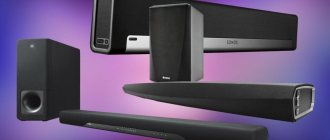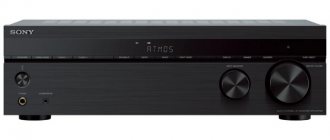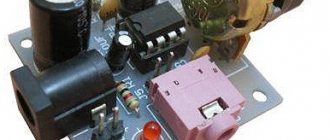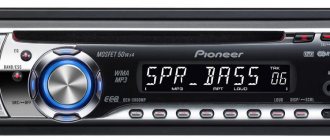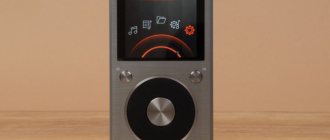FiiO X5
X-fifth costs almost twice as much as X3 - 30,000 rubles. In appearance they look similar, like BMW crossovers. The X-5 is 30 grams heavier and equipped with an improved 2.4” HD display (400×360). Control occurs only with buttons, the screen is not touch-sensitive. The main difference lies in the filling. Looking ahead a little, the X7 has a 3.97″ IPS TFT display with five-finger multi-touch.
The X5's processor remains the same - it's Ingenic JZ4760B . Its power is enough to manage the proprietary OS under which all three players X1 / FiiO X3 II / FiiO X5 II work.
If you listen to the FiiO X5 II through the linear input, then not everyone will notice the difference with the previous generation, because the main improvements were made precisely in the wiring of the digital-to-analog converter. A more professional DAC was chosen - this is Texas Instruments PCM1792A , like the previously reviewed Cowon Plenue 1. With the DAC there are additionally six amplifier chips 2 x OPA1652 + 2 x OPA1612 (a separate low-pass filter has appeared) + 2 x BUF634U .
Inside the player, they gave greater freedom to the bass, slightly reduced the high frequencies, leaving a crystal clear midrange. With Westone armature headphones, you get a “sweet” pair.
I don’t know how much the overpayment compared to the FiiO X3 II matters to many. It seems to me that the difference between the two players will not be immediately noticeable to many, and to get the full picture you need to listen to a well-known album in QUALITY headphones. For most people, the capabilities of the X3 II will be enough. Audiophiles will go further and discover that six chips in the harness make the sound more detailed. Again, I repeat, you need appropriate headphones here.
FiiO X5 II does not have built-in memory. Music is played from two MicroSD memory cards (up to 128 GB each).
The player's characteristics can be found here. The main ones are:
Supported formats : MP2, MP3, AAC, ALAC, WMA, OGG, DSD, APE, FLAC, WAV, AIFF, WMA, Apple Loseless Power source : 3300 mAh battery Operating time : ~10 hours Charging time : Balance: 10 dB Gain : 3.6 dB (Gain=L) / 9.1 dB (Gain=H) Output Level : >1.53 Vrms (10 KΩ/1 kHz) Headphone Impedance Range : 16 – 150 Ω
FiiO X1, X3 II, X5 II review: dot the i's, review. Portal "www.4pda.ru"
So can we say that FiiO players play no worse than many more expensive models from other brands? The answer is yes, but with one caveat. Namely: how was the lower price achieved?
Save and read later -
We tested devices under the FiiO brand a long time ago (it was a portable headphone amplifier E05), but the brand is often mentioned in the comments when the review deals with expensive players. Like, why do we need all these toys at an insane price when there is FiiO! Well, it’s time to figure out what kind of miracle this is, which is so often set as an example for everyone. We tested the current line of FiiO music players to dot all the i’s.
Specifications FiiO X1, X3 II, X5 II
Equipment
The packaging design is the same for all models, although the boxes differ in size. Under the outer colorful “shirt” with the image of the player hides a solid black box made of thick cardboard.
In addition to the device itself, the kit includes a micro-USB cable, which will be needed for charging, loading files from a computer to a memory card, and for the two older models, also for use as a DAC.
The players are supplied in a black silicone case (although the X5 II arrived with an optional transparent bumper), the kit also includes decorative stickers (three sets) that allow you to change the appearance of the player, as well as protective films for the screen (two each for the two younger models and three - for the older one, including the one that is already pasted at the factory), and, well, documentation.
Appearance
All three have the same design, but the finishing is different. The cases are made of aluminum, but the back cover of the X1 is very similar to plastic, while the back of the X3 II is glass. The X5 II has a rough metal texture (brushed) - unlike its younger brothers with their simple matte surface.
The X1 and X3 have a memory card slot on the left side, while the X5 II has two of them and they are located at the bottom, in the same place as the micro-USB connector. The meaning of this doubling is obvious: two 64 GB cards will cost less than one 128 GB card. If you find free funds, you can install a pair of 128 GB, bringing the storage capacity to 256 GB. More precisely, almost up to 256 GB, because it is known that the real capacity is always less than the nominal one.
The X1's headphone output is combined with a linear one, and its function is switched in the setup menu (the output to an external amplifier is unregulated), in the other two models they are separated into two separate connectors, and the linear one can also output a digital S/PDIF signal (switched in the menu ).
The status indicator is a miniature LED, but on the X1 and X3 II players it is located at the bottom of the front panel, and on the X5 II it is built into the power button.
Design
There is no built-in memory. This partly explains the lower cost than comparable players from other manufacturers. You'll have to buy another microSD memory card - unless, of course, you have an ownerless one lying around in your bins.
All three models run on the Ingenic JZ4760B MIPS processor - it is responsible for file decoding, management, displaying information (it has its own video subsystem) and all other service functions. But the designs of DACs and amplifiers are different for everyone. Details are in the table with technical characteristics. Just by the number of operational amplifiers alone, it is clear that the circuits differ in complexity. In addition, the older X5 model uses a higher-class op-amp and DAC. Accordingly, it was necessary to supply older models with more capacious batteries in order to maintain approximately the same battery life.
Note also that the two older models have separate clock generators with frequencies that are multiples of 44.1 and 48 kHz - this is very important for high-quality playback of files with different sampling frequencies. Inexpensive players usually have only one generator (like the X1), so the best decoding quality is ensured only on streams with multiple frequencies. For example, a 44.1 kHz clock generator will provide better sound for 88.2 and 176.4 kHz files, but will play worse at 48, 96 and 192 kHz.
The screens of the X1 and X3 II are the same, 2" each with a resolution of 320x240; the X5 II has a larger screen - 2.4" 400x360, and its quality is clearly better.
Models X3 II and X5 II are capable of working as an external USB DAC. This interface on the two older models supports OTG - if you connect a flash drive through the appropriate adapter, the player will be able to play music from it. But X1 is deprived of such an opportunity.
Control
The structure of the graphical interface (and control algorithm) is the same for all models - except for the differences associated with different functionality (one memory card slot or two, the presence of a USB DAC function, the number of equalizer bands, etc.). The design is somewhat different: the most modest is on the X1, more colorful and bright on older players. The number of themes is the same for X1 and X3 II (6 each), slightly less for X5 II (5), but the quality of texture development improves as the device class increases. Perhaps this was done to make the differences between the models more obvious, or maybe the older ones have more RAM installed, so there is room to store more complex “skins” (probably because the X5 II has fewer of them - they are clearly “heavier”) .
The presence of a large number of “iron” controls made it possible to abandon the touch screen. We’re not sure that this helped reduce costs (high-quality mechanical buttons are not cheap), but it definitely allowed us to increase the battery life, since many operations (for example, moving along tracks) can be performed blindly without turning on the display. And the touch layer itself consumes energy, while the mechanical controls do not “eat” anything, at least until they are touched. By the way, about buttons. All models allow you to choose three locking options: only the volume buttons, they are also plus, in the third option two lower ones are added to them (“Forward” and “Back”). The “donut”, that is, the control wheel is used for all types of movements (through the menu, through the list of files, etc.), it has a pleasant soft-touch coating and is extremely convenient. The volume keys on the left are located at some distance from the power button (it also unlocks the player and turns on the screen), and therefore they are easy to use by touch.
The home screen contains five items arranged in an arc: the first (with an icon of two notes with a jumper) provides access to a complete alphabetical list of files - not very useful if there is a lot of music on the card. But if we press the “Back” button, we find ourselves on the sorting screen and can choose to display not only a list of tracks, but also albums, artists, genres, collections and playlists - we can access this menu immediately by selecting the second icon (note in the background sheet). In the center (folder icon) - access to the directory structure on the memory card. Next is an icon with a note on the background of a gear - these are settings for the playback order, gain, access to the equalizer, etc. Finally, the last menu item (just a gear) is system settings. As you can see, everything is organized logically and intelligibly.
Note that the interface works very smoothly and without any brakes. In general, if we had provided ratings, I would have awarded the entire line “excellent” for ergonomics.
Sound
We will not tire of repeating: everything is learned by comparison. And although the presence of three devices in the review already provides some grounds for comparison, a so-called “reference” technique is needed. In tests of high-end equipment, something completely prohibitive in price is usually used in this capacity, such as a reference in quality (which is by no means always true), but we will go from the opposite: we will compare the sound of players with the Samsung Galaxy S4 LTE smartphone (by the way, not the worst in terms of sound output quality to headphones) with the PowerAmp Pro player. The second “reference” is the same smartphone, but with a “support” in the form of an inexpensive miniature headphone amplifier FiiO Fujiyama E06 (a descendant of the same FiiO E05 amplifier, the review of which was published in our website back in 2008).
The main headphones are Audio-Technica ATH-A900X, as well as the addition of Audio-Technica AD1000x.
The music is very different, from hard rock (Led Zeppelin and Deep Purple) to jazz and classical (in particular, we listened to Gia Kancheli’s latest disc “Chiaroscuro”, released recently on ECM).
We start with a bare smartphone to set a starting point. The ATH-A900X plays quite well, although the dirt in the path interferes with the enjoyment. By the way, if you turn on airplane mode, the sound becomes noticeably clearer, but this does not add to the joy - you can listen to this only if you really want to, but have nothing else to listen to. The FiiO E06 amplifier emphasizes musical expressiveness, energy and pressure increase in heavy music, but the “sand” of the path still remains. When paired with a smartphone and the AD1000x, you feel a dip in the bass.
This is where the help of FiiO E06 comes in very handy: the lows return to normal, the necessary pressure appears. True, I had to play some magic with the output level on the smartphone (after all, it does not have a line output) and select the appropriate equalizer characteristic (imagine, the E06 has two presets). Now you can move on to X-players. Let's start with the youngest.
The difference compared to a smartphone is striking: digital dirt is gone, harmonic resolution has improved, the timbres of acoustic instruments have become more believable, and vocals have become more alive. AD1000x are easy to swing, although with them you have to increase the level a little, but a significant margin still remains. And you don't even have to turn on the equalizer. The difference with the ATH-A900X is, of course, audible, but it is associated solely with the features of the headphones. The additional FiiO E06 amplifier is no longer needed here: the X1 copes well without it.
The X3 II model rocks the AD1000x even more confidently, but the greatest increase in quality is still heard on the ATH-A900X. The sound has become more melodious and smooth, the stage has expanded, its focus has improved, and individual instruments are better heard in intense passages. And most importantly: the degree of emotional involvement has increased, the music has become more powerful.
In addition, it became possible to play DSD files, and their sound seemed more convincing to me than that of PCM 192 kHz/24 bit. We are not able to explain this phenomenon, but the advantages of DSD were undeniable. Usually, as the class of equipment increases, the difference in sound between neighboring models in the line decreases, so we were prepared for the fact that the quality advantages of the X5 II would not be so obvious. We admit, we would even be happy about this: it’s nice to tell music lovers that you can safely save some money by choosing the middle model. Alas, the difference between the X3 II and X5 II turned out to be quite significant. This is partly due to the different DAC chip, although we must give credit to the developers: they managed to squeeze everything that this chip is capable of out of the CS4398, they were even able to smooth out its specific sound character. But we still liked the sound of the PCM1792 more: it has more “breed”, naturalness and realism. It is this higher degree of verisimilitude that distinguishes the X5 from its younger brother, which is why the music sounds more expressive and lively.
In this case, a more advanced and powerful amplifier had an effect: it feels like the headphones are in its complete power, under undivided control. This is most evident in the bass: they are deep and at the same time absolutely distinct. You don’t even think about the high frequencies: they are so pure and natural that you don’t pay attention to them - you just listen to the music.
Autonomy and battery
The declared battery life for the X5 II is 10 hours, for the X3 II - 11 hours, for the X1 - 11 hours with the first firmware version, for subsequent ones it is promised 12-15 hours. In fact, this indicator depends on many factors - the impedance of the headphones, the preferred volume level, the time of screen use, the file format and their sampling rate, as well as the duration of continuous listening.
In reality, it seemed to us that all three models have quite sufficient autonomy, so you won’t need to run from one outlet to another, as you often have to do with smartphones, with FiiO players.
Results
So can we say that FiiO players play no worse than many more expensive models from other brands? The answer is yes, but with one caveat. Namely: how was the lower price achieved?
First of all, due to deliberately reduced costs. Refusal from built-in memory, from touch screens, from some nice functions that you can do without (for example, from the Bluetooth module, which allows you to transmit a signal to the player about incoming calls and messages on the phone) - this makes it possible to reduce costs and sell products for less price.
In addition, there is practically no marketing component in the cost of models of all classes: the price is determined primarily by the design, level of components and, ultimately, high sound quality. You don't pay a penny for anything you don't need, just the sound combined with the features you need.
Pros:
- excellent sound quality;
- classic design and high-quality execution;
- convenient control;
- Protective films and case included.
Minuses: - in models X1 and X3, a silicone case prevents access to the memory card.
Prepared based on materials from the portal “4pda.ru”, November 2015 www.4pda.ruThis review has been read 27,954 times.
Equipment
The packaging design is the same for all models, although the boxes differ in size. Under the outer colorful “shirt” with the image of the player hides a solid black box made of thick cardboard.
In addition to the device itself, the kit includes a micro-USB cable, which will be needed for charging, loading files from a computer to a memory card, and for the two older models, also for use as a DAC.
The players are supplied in a black silicone case (although the X5 II arrived with an optional transparent bumper), the kit also includes decorative stickers (three sets) that allow you to change the appearance of the player, as well as protective films for the screen (two each for the two younger models and three - for the older one, including the one that is already pasted at the factory), and, well, documentation.
Specifications
- SoC: JZ4760B
- DAC: PCM1792A
- LPF: OPA1612
- Amplifier: OPA1612 + BUF634
- Output Power: >255mW @ 32Ω
- Total Harmonic Distortion + Noise: <0.001% @ 1KHz
- Signal to noise ratio: ≥117 dB
- Battery: 3300 mAh
- Charging time: <4h (5V, 2A)
- Operating time on one charge: >10 h (32Ω load, medium volume, display off)
- Dimensions: 109 mm × 63.5 mm × 15.3 mm
- Weight: 165 g
conclusions
In terms of sound, despite the publicized criticism, the device turned out to be quite successful. We also savored the flaws, but... if you pick too hard, problems can be found always and everywhere, especially if you sit in ambush. (That’s what gay robbers do on the road...) However, you can search for your ideal all your life, but never find it. We must learn to appreciate what is really good and what you have here and now...
But I would untie the controls from the entertaining female logic, I would make the navigation normal and logical in our own, audiophile way. I want to intuitively and immediately understand why buttons are pressed and the wheel is turned.
Perhaps someone might even find “Chinese roulette” in the image of a “Ferris wheel” cool and quite convenient, but somehow I didn’t get along with it, I’m such a joker...
Otherwise, I liked the player, in some places even very much. At the time of publication of the review, the price in online stores was 16-17 thousand rubles. And this is at today's dollar exchange rate. The price tag is almost charitable...
Sound quality, two slots for memory cards, high-quality screen, long operating time on a single charge, case, support for most modern formats, relatively low price. Possibility of using the player as a DAC, transport.
Size, very inconvenient controls.
Compatibility
Naturally, this player has enough gain reserve for almost any headphones, if you traditionally do not count tight isodynamics. It works well with both sensitive IEMs and over-ear models that love more power. The redesigned amplifier power circuit allowed the X5-2 to improve compatibility with “hungry” headphone models; you can even listen to it with the AKG K702 (not an ideal option, but quite tolerable).
The player is quite critical of the quality of recordings; due to the natural transmission of the high-frequency range, low-quality tracks will be heard very well, especially if the headphones are not very dark.
By the way, about headphones. Oddly enough, with the X5-2 I liked the good single-driver headphones the most: HiFiMan Re600, Hippo Pro One, “Nails” of various modifications, Dunu Titan 1. The X5-2 was not able to reveal the full potential of the same Dunu DN-2000J, but it's probably not his fault.
Opeth - Burden. Each Opeth track is a discovery, a combination of amazing melody, piercing vocals and sometimes unexpected brutality. Burden's ballad, in fact, is devoid of this aggressive component, plunging the listener into an atmosphere of melancholy and musical self-reflection. Particularly interesting is the transition at the end to the next track, Porcelain Heart, the voice turning into otherworldly sounds and the next explosion of energy you just have to hear. Even if you don't like heavy music, Opeth is worth a listen. Especially with a player like the X5-2, which can convey all the nuances of a track.
Pilate's Dream from Jesus Christ Superstar. Of course, the great rock opera is full of wonderful arias, but for some reason the part of Pilate is often ignored, but in vain. This short composition was performed by Bari Dennen with amazing emotion, which he was able to convey without much difficulty. It is with the X5-2 and its slightly emphasized mids that it is especially interesting to listen to such tracks.
Nightwish - Endless Forms Most Beautiful. The title track from the latest album of the greatest geniuses of music is full of interesting nuances and unexpected moves, showing both the compositional and performing talent of the group. Naturally, to fully perceive this track you need a good source. Needless to say that the X5-2 copes with it, if not perfectly, then very well?
Sound
This is the most interesting part of the review. The following headphones were used for listening: Etymotic ER-4p, Westone UM3X, MyST Nail 2, Beyerdynamic dt-250 (250 Ohm).
The sound turned out to be closer to neutral. I would describe the tonal balance of the Fiio X5 as fairly even. There is depth and good rendering of details. It does not sound tiring, is close to analog and is conducive to long-term listening to musical material.
The virtual scene is well built both in depth and width.
High frequencies are not intrusive, do not hurt the ear, there are not many, not few, there are just as many of them as needed. The only negative here is that the high frequencies are a little crumbly and simplified, but not critical.
Mid frequencies . In this range, in my opinion, there is nothing particularly to complain about. Each instrument is well drawn in space; no obvious distortions are felt in this area. There is no mess, the instruments do not overlap each other. The material is presented whole, but at the same time with good detail.
Low frequencies. In principle, not bad. But not without a flaw. The impact is soft, there is no clarity in the lower range. The bass slows down a bit, it also lacks clarity and speed. But, actually, there is no hum or muttering either. Overall not bad, but could be better.
Appearance
All three have the same design, but the finishing is different. The cases are made of aluminum, but the back cover of the X1 is very similar to plastic, while the back of the X3 II is glass. The X5 II has a rough metal texture (brushed) - unlike its younger brothers with their simple matte surface.
The X1 and X3 have a memory card slot on the left side, while the X5 II has two of them and they are located at the bottom, in the same place as the micro-USB connector. The meaning of this doubling is obvious: two 64 GB cards will cost less than one 128 GB card. If you find free funds, you can install a pair of 128 GB, bringing the storage capacity to 256 GB. More precisely, almost up to 256 GB, because it is known that the real capacity is always less than the nominal one.
The X1's headphone output is combined with a linear one, and its function is switched in the setup menu (the output to an external amplifier is unregulated), in the other two models they are separated into two separate connectors, and the linear one can also output a digital S/PDIF signal (switched in the menu ).
The status indicator is a miniature LED, but on the X1 and X3 II players it is located at the bottom of the front panel, and on the X5 II it is built into the power button.
Packaging and delivery
My copy of the X5-2 arrived in a thick black cardboard box, so I can’t say what the packaging of the “final” version will look like. Most likely, there will be something standard, in red and black colors.
The delivery set includes: the player itself, a black silicone case for it, several spare films for the screen (except for the one already pasted), a MicroUSB cable, an adapter for coaxial output, several vinyl stickers for those who like customization (US flag, wood and carbon).
The silicone case is quite good, but it tends to cling to the lining in your pocket and actively collect dust and threads. I hope Fiio won’t keep you waiting and will release the usual set of accessories for their players, including a leatherette case.
There are no extras, but everything you need is included in the kit.
Results
So can we say that FiiO players play no worse than many more expensive models from other brands? The answer is yes, but with one caveat. Namely: how was the lower price achieved?
First of all, due to deliberately reduced costs. Refusal from built-in memory, from touch screens, from some nice functions that you can do without (for example, from the Bluetooth module, which allows you to transmit a signal to the player about incoming calls and messages on the phone) - this makes it possible to reduce costs and sell products for less price.
In addition, there is practically no marketing component in the cost of models of all classes: the price is determined primarily by the design, level of components and, ultimately, high sound quality. You don't pay a penny for anything you don't need, just the sound combined with the features you need.
Pros:
- excellent sound quality;
- classic design and high-quality execution;
- convenient control;
- Protective films and case included.
Minuses:
- in models X1 and X3, a silicone case prevents access to the memory card.
Control
The structure of the graphical interface (and control algorithm) is the same for all models - except for the differences associated with different functionality (one memory card slot or two, the presence of a USB DAC function, the number of equalizer bands, etc.). The design is somewhat different: the most modest is on the X1, more colorful and bright on older players. The number of themes is the same for X1 and X3 II (6 each), slightly less for X5 II (5), but the quality of texture development improves as the device class increases. Perhaps this was done to make the differences between the models more obvious, or maybe the older ones have more RAM installed, so there is room to store more complex “skins” (probably because the X5 II has fewer of them - they are clearly “heavier”) .
The presence of a large number of “iron” controls made it possible to abandon the touch screen. We’re not sure that this helped reduce costs (high-quality mechanical buttons are not cheap), but it definitely allowed us to increase the battery life, since many operations (for example, moving along tracks) can be performed blindly without turning on the display. And the touch layer itself consumes energy, while the mechanical controls do not “eat” anything, at least until they are touched. By the way, about buttons. All models allow you to choose three locking options: only the volume buttons, they are also plus, in the third option two lower ones are added to them (“Forward” and “Back”). The “donut”, that is, the control wheel is used for all types of movements (through the menu, through the list of files, etc.), it has a pleasant soft-touch coating and is extremely convenient. The volume keys on the left are located at some distance from the power button (it also unlocks the player and turns on the screen), and therefore they are easy to use by touch.
The home screen contains five items arranged in an arc: the first (with an icon of two notes with a jumper) provides access to a complete alphabetical list of files - not very useful if there is a lot of music on the card. But if we press the “Back” button, we find ourselves on the sorting screen and can choose to display not only a list of tracks, but also albums, artists, genres, collections and playlists - we can access this menu immediately by selecting the second icon (note in the background sheet). In the center (folder icon) - access to the directory structure on the memory card. Next is an icon with a note on the background of a gear - these are settings for the playback order, gain, access to the equalizer, etc. Finally, the last menu item (just a gear) is system settings. As you can see, everything is organized logically and intelligibly.
Note that the interface works very smoothly and without any brakes. In general, if we had provided ratings, I would have awarded the entire line “excellent” for ergonomics.
We will not tire of repeating: everything is learned by comparison. And although the presence of three devices in the review already provides some grounds for comparison, a so-called “reference” technique is needed. In tests of high-end equipment, something completely prohibitive in price is usually used in this capacity, such as a reference in quality (which is by no means always true), but we will go from the opposite: we will compare the sound of players with the Samsung Galaxy S4 LTE smartphone (by the way, not the worst in terms of sound output quality to headphones) with the PowerAmp Pro player. The second “reference” is the same smartphone, but with a “support” in the form of an inexpensive miniature headphone amplifier FiiO Fujiyama E06 (a descendant of the same FiiO E05 amplifier, the review of which was published in our website back in 2008).
The main headphones are Audio-Technica ATH-A900X, as well as the addition of Audio-Technica AD1000x.
Autonomy and battery
The declared battery life for the X5 II is 10 hours, for the X3 II - 11 hours, for the X1 - 11 hours with the first firmware version, for subsequent ones it is promised 12-15 hours. In fact, this indicator depends on many factors - the impedance of the headphones, the preferred volume level, the time of screen use, the file format and their sampling rate, as well as the duration of continuous listening.
In reality, it seemed to us that all three models have quite sufficient autonomy, so you won’t need to run from one outlet to another, as you often have to do with smartphones, with FiiO players.
FiiO A5 sound test
The amplifier was tested in two stages. The headphones remained unchanged. The source used was FiiO X1 II and everyone's favorite iPhone 6s Plus.
In the first case, there is nothing to tell - you need to hear it with your own ears. Excellent detail and the correct bass of the player is not distorted or lost. Everything remains in place, but becomes much louder. Enabling Bass Boost solves the issue of a smooth frequency response and perfectly colors low frequencies.
It’s a pleasure to listen to hip-hop and alternative metal on such a combination. Goosebumps, hair standing on end. You know how it goes. At maximum volume, the headphones can be used as portable speakers.
Unfortunately, the used headphones are not able to reveal the connection between two FiiO devices. In this case, you need to use something even more serious.
Connecting the amplifier to the iPhone did not disappoint. Compared to the combination of player + amplifier, the stage is a little compressed, the detailing of the upper range is worse. Yes, and extremely low frequencies cannot be heard. But in order to sort out these shortcomings, you need to have remarkable training and an ideal ear for music.
Perhaps, for most users it is worth recommending just such a combination: a smartphone with good sound and a FiiO A5 . This is enough for any music, any headphones. Crystal clear and extremely powerful sound.


